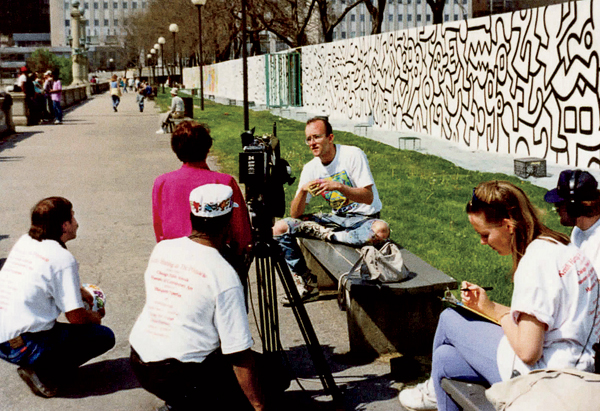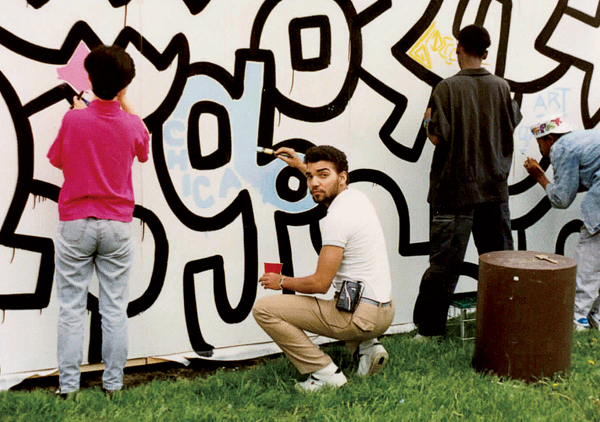Madonna was the biggest pop star in the world in 1989, and her good friend Keith Haring was the planet’s most recognizable artist. By the time the New York painter visited Chicago in May of that year, his renderings of people and cityscapes in fat black lines had become iconic. So when he descended on Grant Park to create a mural with nearly 500 students from Chicago public schools, the spotlight followed. WTTW produced a documentary for the occasion and booked Dennis Hopper to narrate it (see below). Suburban teenagers skipped class to drive in and catch a glimpse of Haring. Nine months later, he would die of AIDS-related complications.
The Grant Park mural was one of four that Haring created during his brief residency in Chicago (two smaller contributions were made for Rush University Medical Center and one for Wells Community Academy High School in Ukrainian Village), and it was the most impressive and ambitious, stretching across 488 feet of Masonite panels, Haring’s outlines filled in with bright colors by the CPS students.

Though it’s one of Chicago’s greatest public artworks, the Grant Park mural is also its most rarely seen. The completed piece stood for only a week before its 122 panels were separated. Some went into storage. Others were hung in CPS offices and schools. The largest chunk—36 panels—was placed in the pedestrian tunnel connecting the Orange Line to Midway Airport. Those panels, removed in February because of construction, anchor a new exhibit at the Chicago Cultural Center, opening March 3.
The idea for Haring’s stint in Chicago sprouted when a mutual friend introduced him to Irving Zucker at a gallery opening in 1987. A music aficionado and CPS educator who worked to bring jazz programs into the city’s schools in the ’80s, Zucker was deeply invested in urban arts enrichment. When the friend suggested an arts education project in Chicago, recalls Zucker, “Keith invited me to his studio the next day, and we began brainstorming.” The project they envisioned was a mural to be painted by kids from 54 public schools (they ended up getting 47) and eventually broken up and exhibited in those schools.
A real estate developer donated the money for materials. Cabaret Metro owner Joe Shanahan offered up his rock club for a wrap party. And Haring, an advocate for public art, volunteered his time. When the students arrived at Grant Park on May 17, Haring had painted them a giant coloring book—outlines of dancing figures, barking dogs, and the skyline, which he guided the students in filling in. Some drew their initials. Others infused whole figures with blue, pink, green, orange. Some wrote things (“Stop the Violence,” “Stop Gangs”), while others sketched pictures (Daffy Duck, a dozen Venus symbols).
“He was never condescending when he worked with kids,” says Zucker, who is now retired and living in Guatemala. “Imagine making a 488-foot mural while enduring a fatal disease.”
The plan was that after its Grant Park installation, the mural would be moved to a construction site for a year—surrounding a tower that the developer who’d financed it was going to build—before being shipped to the schools. But when the construction project fell through, CPS stowed the panels. (They appeared together only twice more, during the summers of 1991 and 1992 at Gallery 37.) “There are sections in high schools that didn’t even exist when the mural was created,” says Zucker. “Others were lent to institutions out of state.” The Midway portion spent years exposed to grime and vandalism.
Through September, those panels will now line a gallery at the Cultural Center, alongside ephemera from Haring’s five-day visit—drawings he made on T-shirts, a card he wrote to Zucker, a doodle he scribbled on a Godiva box. Some students who had been involved may give talks. The objective is to focus on the mural’s ripple effect in Chicago. “A lot of the kids who worked on it are now artists themselves, doing workshops in the city,” says Nathan Mason, who curated the show.

The exhibit also serves as a homecoming for an artwork long relegated to the outskirts of the city. “When you look out the window in the Cultural Center,” says Mason, “you can see where it was originally painted.”
Haring’s panels could still end up in the city’s public schools. In 2015, a committee was assembled for the purpose of mounting the full mural at Expo Chicago at Navy Pier in 2019 for the work’s 30th anniversary. Zucker hopes that afterward the panels will return to the communities that made them, as Haring intended. “Keith had a commitment to urban youth and urban culture—a need to make life better for others with his art,” says Zucker. “He worked until the end to do that, with his art and with his soul.”
Watch the WTTW documentary below:



